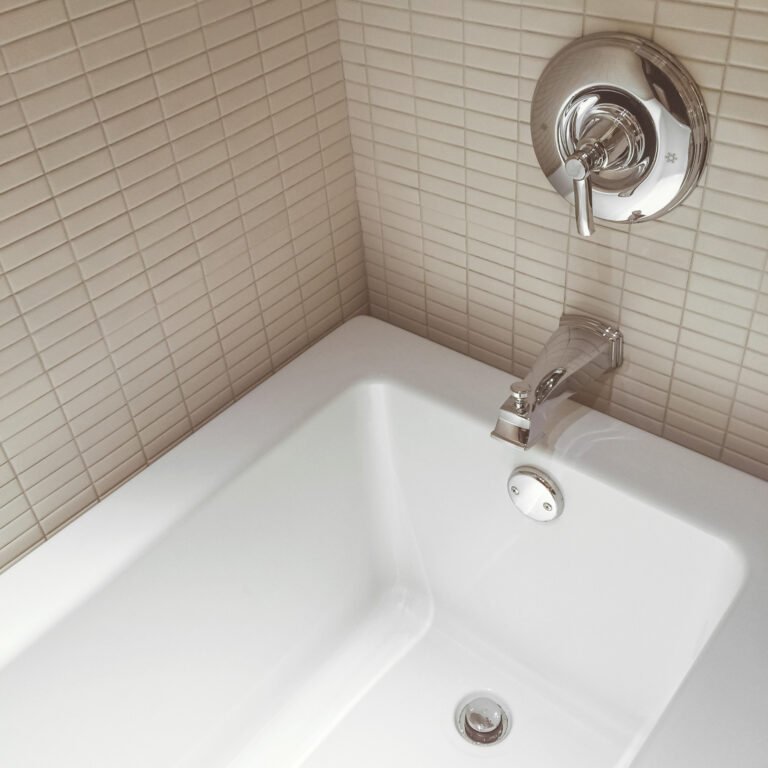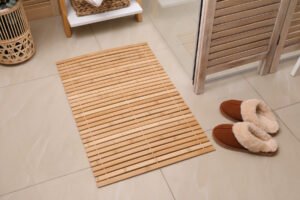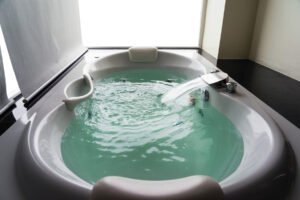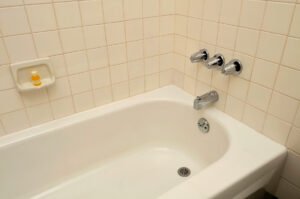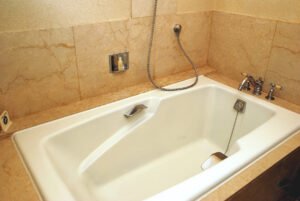Soaking tubs are indeed the need of the hour! They keep you happy and hearty, reduce joint pain, and eliminate the stress of corporate life. A bathtub drain stopper will help you retain or drain the water as and when you need to make soaking easier.
However, picking the best stopper for your bathtub is tricky as each has a separate work mechanism.
Here, we bring to you some of the best types of bathtub drain stoppers based on their mechanism, material, shape, and design, along with some tips and FAQs to make selection easier. So, without further ado, let’s dig into the list.
What Is a Bathtub Stopper?
A bathtub drain stopper is a minor drain fitting, like a cover that plugs the drain hole and retains water for soaking in the bathtub. Once done, you can instantly remove its plug from the tub drain to drain all the dirty water.
How Does a Bathtub Stopper Work?
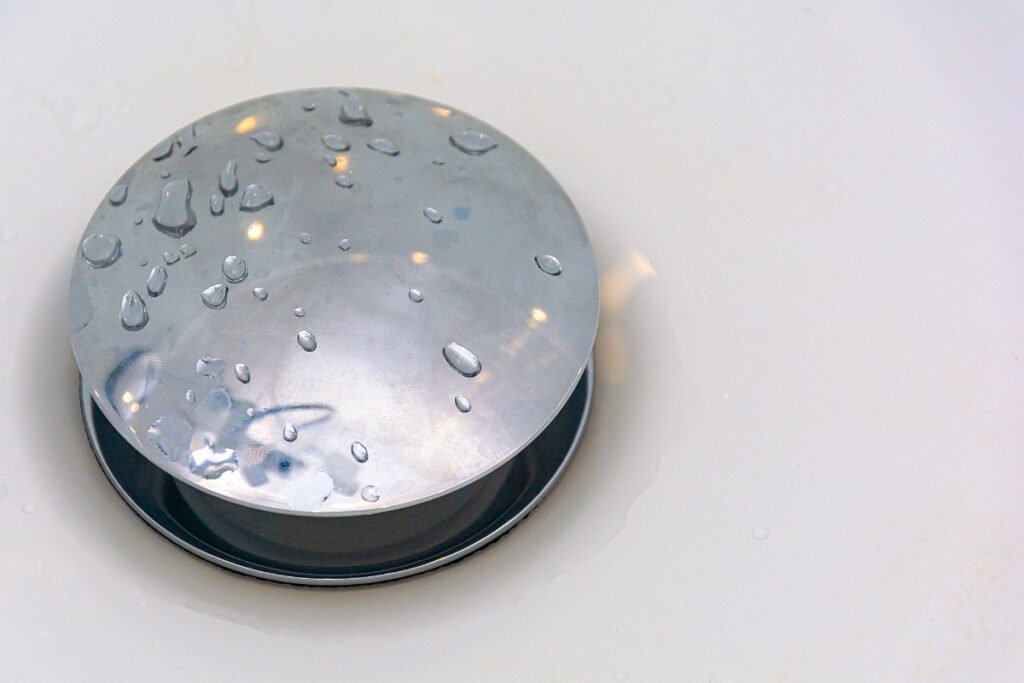
A bathtub drain stopper has a plug and a lever attached to a pivot ball assembly and a rubber drain seal or cover. The lever has a spring that extends from the tub’s overflow plate to the rubber seal and raises and lowers the rubber cover as required.
Pulling the drain plug releases the seal and opens the drain, whereas pushing it downwards stretches the string, fixes the seal, and makes the tub ready to retain water. However, you must consider then your tub might not drain properly without a bathtub vent.
How to Choose a Bathtub Drain Stopper?
Bathtub drain stoppers come with different mechanisms, prices, installations, and materials, but not each one will be the best fit for all types of bathtubs. So, we gathered some helpful tips and considerations that will be handy in picking a new tub stopper.
- Size: Drain stoppers come in three variants – small, medium, and large. Hence, before purchasing a new one, measure the tub’s drain body and pick a stopper that doesn’t get stuck. You can even look for the specifications of your old tub drain stopper to check its size for reference.
- Price: Price is essential in remodeling your bathtub on a budget. Generally, metal drain stoppers are more expensive and cost about $25-30 per piece, whereas silicone ones are more economical and cost $10-15 per piece.
- Material: Material affects the durability of the drain stopper in the long run. Generally, metal drain stoppers tend to last longer than plastic or silicone ones that split and crack on continuous exposure to water. So, if you do not want to replace your drain stopper, again and again, pick good quality steel or galvanized iron stopper.
- Designs: Pick fancier, abstract, or animal-form silicone drain stoppers for kid bathtubs while going for sturdier, minimal metal designs for walk-in bathtubs or industrial decor bathrooms.
- Mode of Operation: If you have no time for maintenance, choose a simple, push-pull drain stopper that traps dirt and debris on its own, while pick toe touch stoppers for easier operations if you have older people at home.
Types of Bathtub Drain Stoppers – Based on Mechanism
1. Push & Pull Bathtub Drain Stopper
Ideal For: Generic Bathtubs, Soaking Bathtubs, and Acrylic and Enamel bathtubs that need softer handling and installation.
A push-pull drain stopper comes with a knob and cap design with a durable rubber seal that fits seamlessly into the tub drain. These rubber seals loosen up when you pull the knob and allow water to drain through the tub, whereas they create a solid vacuum when you push the knob and retain water in the bathtub.
Moreover, this drain stopper doesn’t require much maintenance; simple rinsing with baking soda and white vinegar will be enough. To do so, unscrew the stopper from the drain crossbar, clean it, and attach it again. You can also use a plunger to remove clogged hair, grout, and solid waste accumulations.
What we like about it:
- Long-lasting, Durable, and Cost-effective.
- Simple and ergonomic design that doesn’t require much maintenance and repair.
- Easy to install and creates a perfect seal.
- It fits a variety of bathtub drains and pipes.
A push-pull drain stopper might wear with continuous operation. Hence, add an extra set screw to the stopper body for better support and wear resistance.
2. Lift & Turn Drain Stopper
Ideal For: Ideal for sturdier metal bathtubs, jetted tubs, whirlpools, air tubs, and even Jacuzzis and spas.
Lift and turn drain stoppers are tricky to use but have a solid and sturdy metal body that adapts to everyday use without much repair. However, operating the plug is challenging, and you’ll need to bend over, align the pin to the drain and press it tightly to close it. And to loosen it, rotate the stopper counterclockwise.
Further, a lift & turn drain stopper is highly flexible and fits well in medium and large-size bathtubs with a conventional metal drain basket. However, the stopper body might rust and corrode easily with continuous use and may require cleaning with an anti-rust solution from time to time.
What we like about it:
- Sturdy and heavy-duty design that lasts long.
- Flexibility to fit abstract-shaped or non-conventional tubs of any size.
- Compatible with most of the plumbing fixtures, traps, and overflow tubes.
Old stopper threads might create more friction and make it difficult to rotate the stopper. Hence, insert a screwdriver in the cap and pull it up a little for easier drainage.
3. Pop-Up Drain Stopper
Ideal For: Ideal for a smaller corner tub, walk-in, or clawfoot tub, and a three-wall alcove or free-standing bathtub.
Pop-up stoppers come with a trip lever drain stopper on their overflow plate to control and are easy to install and use.
When rotated clockwise, the trip lever twists the connecting rod, presses its string downwards, and pushes the plug inside the drain opening. And when rotated counterclockwise, it releases the spring and opens the drain.
However, this complicated mechanism makes it vulnerable to hair and debris clogs and may require cleaning from time to time. Moreover, the metal connecting rod and trip lever might weather and rust with continuous use and need oiling for a smooth operation.
Overall, this drain stopper is great for small, budget bathtubs with lesser water capacity.
What we like about it:
- Low-cost and Affordability.
- It is convenient and accessible to people from all age groups.
- It is durable and flexible enough to fit into a drain pipe of any size and material.
You’ll need to replace the stopper if the connecting rod gets damaged. Hence, clean it with an anti-rust solution and oil it once weekly for optimal function.
4. Flip-It Tub Drain Stopper
Ideal For: Recommended for a bathtub without a drain strainer, clawfoot tub, spa tub, soaking tub, and corner tub.
Flip-it stoppers are extremely handy, having a toggle lever that opens and closes the rubber seal to drain or retain water. Additionally, the toggle lever has O-shaped rings at the bottom that create a watertight seal when you push the lever down and release it when you pull it upwards.
These stoppers are easily accessible from arm’s length and don’t require any bending or pushing. Hence, they are accessible by one and all and don’t require special maintenance other than frequent cleaning with a flat-headed screwdriver.
What we like about it:
- Easy to install, use, and replace.
- Universal in nature and doesn’t require any additional plumbing fixtures & equipment.
- Suits both indoor and outdoor applications, bathtubs, and spa pools.
The rubber elasticity of O-rings might go down with continuous use and wear and tear. Hence, check for any signs of damage and replace them immediately.
5. Toe Touch Stopper
Ideal For: Recommended for free-standing clawfoot, alcove and soup-bowl, and shower drop-in tubs.
A push-pull drain stopper is operated by the hand, whereas a toe touch or foot accentuated stopper can be used with your toe. Thus, it is convenient and makes it easier to open and close the drain universally. Plus, it is effortless to install and maintain and can easily fit a majority of drains and plugs.
The toe-touch stopper has a spring that connects the stopper body to the crossbar and controls the drain plug through a dry screw underneath the cap.
Thus, the drain plug tightens and retains water when you push the stopper down with your toe. Then, press it again, loosen the seal, and drain the water into the bathtub trap.
What we like about it:
- Affordable and convenient to use universally.
- Requires little maintenance and does not clog easily.
- It suits walled, walk-in, and standalone tubs and fits nicely into the overflow pipe of each.
Continuous use might damage the bathtub spring, and they might wear out easily due to friction. Hence, oil and lubricate the springs from time to time.
6. The Trip Lever Stopper
Ideal For: Ideal for conventional rectangle, ellipse, triangular bathtubs, hot tubs, Japanese tubs, and walk-in spas.
The trip lever stopper is inexpensive; surprisingly, there is no visible stopper device on the top of the bathtub plug. Instead, it’s a mechanism that operates through a plunger in the drain pipe and controls the plumbing supply through a connecting rod in the drain opening.
Pulling the trip lever upwards lowers the plunger, twists the overflow plate, and closes the drain opening, thus retaining water in the tub. In contrast, pushing the lever downwards raises the plunger and opens the drain opening to drain the water outside.
What we like about it:
- Pretty inexpensive, easy to install, and maintain.
- Allows fast and smooth drainage.
- Drains solid waste deposits, debris, or hair effectively and does not clog often.
The plunger is difficult to clean and must be pulled out of the overflow plate and drain assembly for rinsing.
7. Stopshroom Plug
Ideal For: Ideal for most tiled and brittle enamel or porcelain bathtubs with a conventional tub drain.
A stopshroom plug is a flexible, detachable bathtub plug that you can insert or remove to hold or drain water from the tub. It comes with thick, silicone-based plugs and a hoop handle with a movable knob that makes inserting or pulling the plug easier. However, it wears with use and often needs replacement.
What we like about it:
- Stretchy and flexible, adapting well to various drain pipes and strainers.
- It doesn’t remain in the bathtub, and you can remove it when not in use.
- Inexpensive and doesn’t need additional maintenance or installation expenses.
The continuous movements of twisting, curling, pulling, and pushing the stopper might cause wear and tear and need replacement.
Bathtub Drain Stopper Types – Based on Materials
Bathtub drain stoppers come in metal and rubber-based materials, each of which has pros and cons and fits each bath design differently. So, let’s explore some popular bathtub drain stopper materials and pick the one that suits you best.
1. Silicone Tub Stoppers
Where to use: Stopshroom plugs, push & pull, lift & turn stoppers, and flip drains.
Silicone is a highly flexible and adaptable stopper material that stretches to fit odd-sized drains and traps but creates a tight water seal that effectively retains water. Moreover, silicone stoppers are easy to install, maintain and replace. Plus, their soft nature makes them easier to clean, rinse and disinfect.
2. Metal Drain Stoppers
Where to use: Toe touch and trip lever stoppers, Flip-it up, and pop drain stoppers.
Metal drain stoppers are sturdy, minimal, long-lasting, and cannot deform easily. In addition, they have a simple-lever mechanism that operates at arm-reach and thus, are universal.
However, since metal is a corrosive material, metal stoppers might rust and weather on continuous exposure to water and need an anti-rust treatment frequently.
Moreover, they are a bit challenging to clean, and you’ll need to unscrew them with a drain wrench, pull them out, wash them properly and replug them again.
3. Rubber Stoppers
Where to use: Stopshroom plugs, Outdoor jacuzzis and tubs, Toe touch and flip-it stoppers.
Rubber stoppers are soft, flexible, and adaptable and come in a standard size of 2-inch knobs that stretch or contract to fit odd-sized drains and create a tight water seal.
Moreover, they are incredibly soft, lightweight, and easier to insert and lift. Furthermore, rubber is easier to clean, does not stain easily, and maintains its original color for a longer time.
4. Plastic Stoppers
Where to use: Flip it and lift and turn stoppers, pop up, and push-pull stoppers.
Plastic drain stoppers are handy, lightweight, and affordable. They come in abstract shapes and colors and are softer to touch, making them the right tap for kids’ bathtubs and spas.
However, they are very brittle and can break or melt if left in hot water for a long time. Plus, they are a little tricky to clean and may deform if handled roughly.
Are Bathtub Drain Stopper Plugs Universal?
Yes, bathtub drain stopper sizes are standardized, about 1.5 inches in diameter, and fit well in 14-26 inches deep tubs. They might not work well if you have old, abstract, or cramped corner tubs, but you can directly connect them to the p-trap or the drain pipe for an optimal function.
And, if you want a stopper plug for your bathtub cum shower drain, grab a large, 3-inch stopshroom plug that stretches, contracts, or expands but fits well to any odd-sized overflow drain.
How to Install a Standard Bathtub Drain Stopper Efficiently?
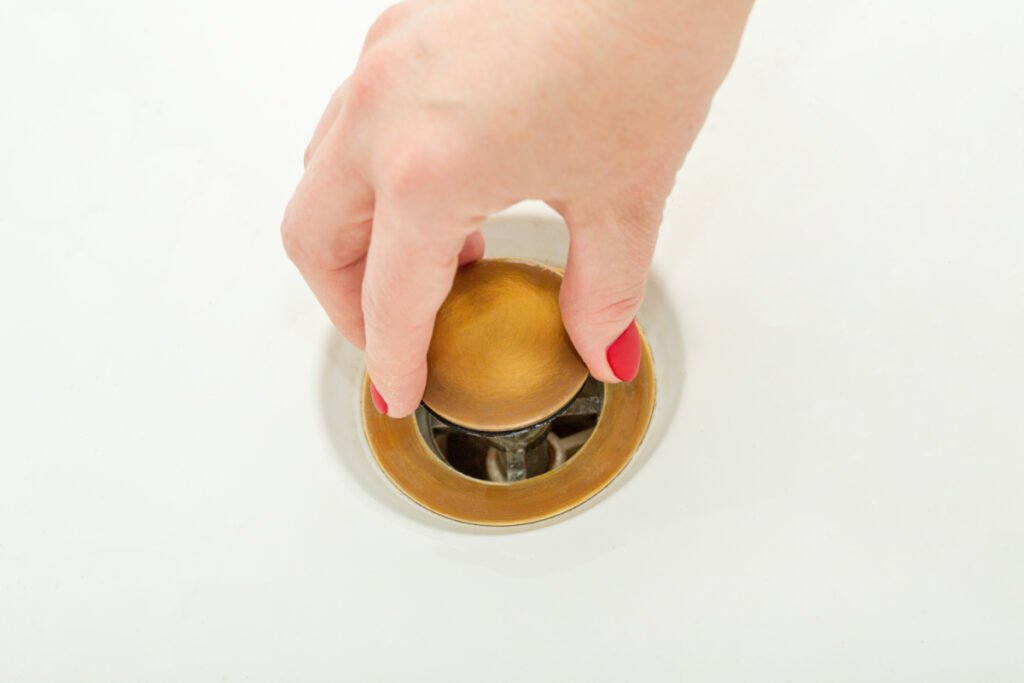
Tools You Will Need:
- Screw-driver
- Tub drain wrench or pliers
- Putty Knife
- Drain converter kit for sink or bathtub
- Plumber’s putty
- Scouring pad
Instruction:
Step 1: Remove the existing drain fitting using adjustable pliers or a drain wrench, clean off the ring and scrub off the existing plumber’s putty with a scouring pad.
Step 2: Pick the appropriate drain stopper from your converter kit, and apply the plumber’s putty to its flange. Insert the fitting into the drain opening, wipe off the excess putty and test the drain.
Step 3: Lastly, press the stopper downwards and retain water in the tup for about 10-15 minutes before draining it. You can even polish your metal stopper with an antirust solution or enamel for more durability. Also, clean the bathtub drain regularly.
How Do You Clean a Bathtub Drain Stopper?
Bathtub drain stoppers weather away due to accumulated calcium, sediment, or rust in their strainers or outlets. You can push any such deposits away using needle-nose pliers, toothbrushes, or screwdrivers. Alternatively, you can rinse them with white vinegar, peroxide, or baking soda solvents to remove all the stains and rust from the stopper body.
Are All Bathtub Drain Stoppers the Same Size?
Bathtub drain stoppers are not necessarily the same size, but most have a 1 ½ or 2-inch diameter that fits most bathtub drains well. However, smaller corner tubs or jacuzzi tubs may have a smaller drain opening of about 1 ¼ inch, and you can easily use a custom-made stopshroom plug to cover its drain.
How Do You Measure a Bathtub Drain Stopper?
Bathtub drain stoppers are usually 1 ½ to 2 inches in diameter, but you can measure their height from the center of the overflow tube to the underside of the tub and find the one that best suits your tub.
Bathtub drain stoppers are crucial for a good soaking experience, retaining or draining the water. While metal ones are durable and long-lasting, silicone and conventional plugs are sturdier.
Although drain stoppers will keep your bathtub clean for a long time, it is still prone to staining and bacterial growth. In this case, our effective bathtub cleaning tips & tricks will come in handy!

